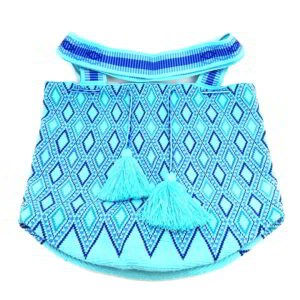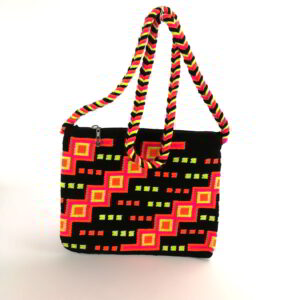Wayuu Weaving, Designs and Patterns
 Where does Wayuu fabric originate?
Where does Wayuu fabric originate?
Regarding the Wayuu fabric, we must highlight its mythological origin narrated in the legend of Wale’kerü that is handled within the culture of this ethnic group.
The Wayuu women are in charge of making these wayuu bags, they imprint on them all the cultural and traditional customs of their ancestors as well as their own experiences and legends of the indigenous community.
Well, it does not represent only a craft, but also everyday stories that go beyond culture and customs are the heritage that Wayuu wisdom and feeling have transmitted.
Wayuu weaving is rich in traditional designs called kaanas
Most of the designs represent important figures for the Wayuu people. The compositions are made through the repetition of geometric figures.
The most prestigious abstract representations are those of the native fauna and flora and each symbol has its meaning.
This ancestral technique dates back to the pre-Columbian period and is used in the production of pieces that, due to their great beauty and color, are the most appreciated among the Wayuu.
 Motifs and design patterns
Motifs and design patterns
The traditional motifs of the Wayuu weaving with the kaanas are the most authentic expression of the way the Wayuu interpret and represent the elements of the material world that surrounds them and their daily life, in order to create figures full of great symbolism.
These geometric compositions are repeated throughout the fabrics, each of which receives a name that expresses its meaning..
For example:
Pulikerüüya; like the genitals of the donkey. Molokonoutaya; like the shell of the morrocoy.

Pasatalouya; like cow guts. Kuliichiya, like the fabric formed by the roof poles.

Siwottouya, like the footprint left in the sand by a trained horse. Marüliunaya; like the engraving that is made on the milking totumo.

Jalianaya, who is the mother of kaanás. Paralouas, that is above each other.

Kalepsü, like the wooden hook used to hang objects from ceilings. Antajirasü, that intersect.

Jimeuya, like the eye of a fish. Ulesia, what does clean mean.

To these geometric figures of the Wayuu fabric are also added other figures such as hourglasses, triangles, stars, diamonds, arrows and blocks. In addition to some drawings of faces or plants; Sometimes we can even find wayuu bags with words or phrases about their ethnicity, as well as pre-Columbian designs.
